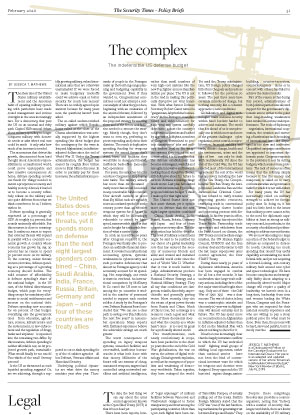The indefensible US defense budget
The sheer size of the United States military establishment and the American habit of equating military spending with patriotism have made sound management and serious oversight in the area increasingly rare. For a democracy, that puts the US on an unusual and risky path. Capitol Hill’s annual debate about military spending no longer compares military with domestic needs or asks where real cuts could be made – it only asks how much of an increase is needed.
The momentum that drives this growth, disconnected from hard thought about America’s responsibilities in a transformed world, could prove unstoppable and have massive consequences. At home, defense spending crowds out funds for things needed to ensure a prosperous economy and healthy society. Abroad, it has led us to become a country reflexively reliant on the military and one quite different from what we think ourselves to be or, I believe, wish to be.
Defense spending is generally expressed as a percentage of GDP. At roughly 3-4 percent, that sounds eminently affordable. But this measure is close to meaningless. It makes no sense to expect that external threats will expand in parallel with a country’s economic growth. A country whose economy has grown by, say, 30 percent has no reason to spend 30 percent more on its military. To the contrary, unless threats worsen over time, defense spending as a percentage of a growing economy should decline. The valid measure of affordability is defense spending’s share of the national budget – in the US case, of the federal discretionary budget, which pays for everything except for mandatory allotments to social entitlements and interest on the national debt. Defense spending now accounts for 60 percent of that budget: everything else the government does – from education, agriculture, science, infrastructure and the environment, to law enforcement and the regulation of drugs, banks and airplanes – is squeezed into the remaining two-fifths. By this measure, defense spending is neither affordable nor, on its projected growth path, sustainable. What would finally be too much? Two-thirds of the total? Seventy percent?
Is the US as threatened as such lopsided spending suggests? Or, are we achieving, through a rapidly growing military, valued international aims that are otherwise unattainable? If we were forced to make budgetary tradeoffs could we achieve equal or better security for much less money? There are no widely agreed upon answers because for many years now, the questions haven’t been asked.
The so-called undernourished military against which Republicans railed at the close of the Obama administration was actually supported by the highest spending (the direct budget plus the contingency for the wars in Iraq and Afghanistan) in inflation-adjusted dollars since the end of World War II. Under the Trump administration, the budget has soared by roughly $100 billion more to $738 billion this year. In order to partially pay for these increases, the administration proposed to cut or slash spending for 13 of the 16 cabinet agencies – all but Defense, Veterans Affairs and Homeland Security.
Underlying political dynamics are what drive the money machine year after year. Thousands of people in the Pentagon make up the best long-range planning and budgeting capability in the government. Even if they wanted to, Congressional committees could not attempt a serious analysis of what they produce, beginning with an evaluation of the asserted threats, followed by an independent assessment of the proposed strategy for meeting them and of the forces and facilities needed to execute the strategy. Mostly though, they don’t want to even try, preferring to protect spending and jobs in their districts. The result is duplicative spending, funding for weapons systems the armed forces don’t want, bases and facilities they would like to close, and bloated, inefficient back-office (noncombat) operations.
For years, the army has tried to convince Congress to stop buying new tanks. The military already has more than six thousand – vastly more than would be needed in any conceivable future combat. New aircraft carriers, at more than $13 billion each are arguably more an outdated symbol of 20th-century power than an effective weapons system for a future in which they will be increasingly vulnerable to attack by high-speed, maneuverable missiles that can be bought for a miniscule fraction of what a carrier costs.
In 2018, an incredible 26 years after Congress required it, the Pentagon was finally able to produce an auditable financial statement. It revealed a nonfunctional accounting system, systemic weaknesses in cybersecurity and such pervasive deficiencies that almost no Pentagon agency could accurately account for its spending. Not surprisingly, one result is waste in overhead. An international comparison by McKinsey & Co. rated the US next to last among the 30 countries it studied in the number of personnel needed to support each combat soldier. A study by the Pentagon’s own Defense Business Board concluded that “We can see a clear path to saving over $125 billion in the next five years” in noncombat operations. Many experts with firsthand experience believe the achievable savings are much greater.
The worst consequence of spending on legacy weapons systems, unneeded facilities and over-staffed, inefficient bureaucracies is what isn’t done with that money. Militaries of the future will use swarms of cheap, unmanned weapons, targeted and controlled using networked satellites and artificial intelligence, rather than small numbers of very high-cost systems like the new F-35 fighter at more than $90 million per plane. The US is not in the lead in making this politically disruptive yet vital transition. With what former Defense Secretary Robert Gates termed a “gargantuan, labyrinthine bureaucracy” in the Pentagon, manufacturers and subcontractors for each weapons system carefully distributed across the country’s congressional districts and backed by aggressive lobbyists, members of Congress determined to protect constituents’ jobs and military leaders loyal to the weapons systems they trained on and commanded, it is no surprise that the defense establishment has become extravagant, wasteful and less agile, innovative and forward-looking than it should be. Trump, still defensive about his failure to serve in Vietnam, is making things much worse. Last year, he boasted that with his immense $750 billion proposed defense budget “I think I make up for that right now.”
The United States does not face acute threats, yet it spends more on defense than the next eight largest spenders combined – China, Saudi Arabia, India, France, Russia, Britain, Germany and Japan – and four of these countries are treaty allies. The disproportion has held for decades. This level of military commitment might be said to be justified by our choice of a global leadership role that has ensured the security of numerous friends and allies and created and sustained a peaceful world order since the end of World War II. Whether that is true is much harder to judge. Administrations produce a National Security Strategy, a National Defense Strategy and a National Military Strategy. They all say that conditions are dangerous, volatile, disorderly, unpredictable and generally getting worse. More recently, they cite the return of great power threats from Russia and China. Much of this is true, but a strategy is a means to reach a goal and what none of these documents does – and what the country as a whole hasn’t done – is to reset its goals for a profoundly altered world.
Five transformations, each nearly revolutionary in scope, have been packed in to the short 30 years since the end of the Cold War: globalization, the war on terror, the advent of digital technology, China’s growth explosion, as well as the emergence of populism and weakening of democracy worldwide. Taken together, they have reshaped the world. Yet until the Trump administration, US foreign policy changed little from the goals and practices it followed for the previous 70 years. The past three years have certainly introduced change, but nothing remotely like a coherent approach to new conditions.
Globalization and digital technologies make national security within fixed borders harder to achieve and maintain. The world that lies ahead of us is unequivocally one in which more and more of the greatest challenges – cyber regulation, arms control, nonproliferation, financial stability and trade, climate change, health and the environment, crime and the rule of law – can only be dealt with multilaterally. Yet since the end of the Cold War, the US has rejected most of the international agreements the rest of the world has approved, including the Law of the Sea Treaty, the Comprehensive Test Ban Treaty, the Antipersonnel Landmine Ban and the International Criminal Court. It has refused to ratify treaties protecting genetic resources, restricting trade in conventional arms, banning cluster bombs and protecting persons with disabilities. In his few years in office, President Trump has rejected the Trans-Pacific Partnership trade agreement and withdrawn from the Paris Accord on climate, the INF Treaty on intermediate-range missiles, the UN Human Rights Council, UNESCO and the Iran nuclear deal and threatens to kill the last major superpower arms control agreement, the New START Treaty.
During these nearly 30 years of diplomatic withdrawal, America has been engaged in combat for all but a few months. It has undertaken nine large-scale military actions, including three of the five major wars it has fought since 1945. Only one of these – the Gulf War of 1990–1991 – was a clear success. The war of choice in Iraq was a catastrophic mistake and the nearly 20-year war in Afghanistan will almost certainly end in failure. The US has spent more on reconstruction in Afghanistan in inflation-adjusted dollars than it did on the Marshall Plan with almost nothing to show for it.
It has become increasingly clear that the largely intrastate conflicts in which the US has embroiled itself – fighting small groups of shifting, local opponents, rather than national armies – have not been the kind of conventional interstate wars for which its weapons and doctrine were designed. Every approach the US has tried – regime change, nation-building, counter-terrorism, counterinsurgency – alone or in concert with others, has failed to achieve the desired results.
Part of the reason is that during this period, administrations of both political parties have allowed support for the government’s diplomatic arm to wither to the point that long-standing weaknesses have resulted in serious underperformance. The tools of diplomacy – negotiation, international cooperation, the creation and nurturing of institutions and the making of international law – are disparaged as too slow and ineffective. Unqualified campaign contributors are appointed to important diplomatic posts. Congress responds to the problems it sees by cutting budgets, which creates more problems. The lack of resources often means that the military, simply because it has the money and manpower, is called on to carry out humanitarian and governance tasks for which it is not well-suited.
For many years, the US has increasingly relied on military strength to achieve its foreign policy aims. In doing so, it has paid too little heed to the issues that military power cannot solve, to the need for diplomatic capabilities at least as strong as military ones and, in particular, to the necessity of multilateral problem-solving to address current threats.
We are now allocating too large a portion of the federal budget to defense as compared to domestic needs, tolerating too much spending that doesn’t buy useful capability, accumulating too much federal debt, and yet not acquiring a forward-looking, 21st-century military built around new cyber and space technologies. We have become complacent and strategically flabby about adapting to a profoundly altered world. Major change will require a quality of leadership we haven’t seen in a long time, leadership from men and women leading the White House, Congress and the Pentagon who are respected for their national security experience and who are willing to pay a steep political price for what must be done. Even then, the process will be hard, slow and painful, but it is surely overdue.
JESSICA T. MATHEWS
is a Distinguished Fellow at the Carnegie Endowment for International Peace. Her piece is an adapted and updated version of her article “America’s Indefensible Defense Budget,” New York Review of Books, July 16, 2019.




